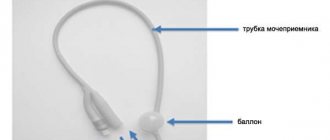Main indications for catheter placement
The main indication for installing a catheter is urolithiasis in a cat, in which there is impaired insufficient urine flow. This violation can be noticed by several signs.
- Small puddles outside the tray to the whole house. This happens due to the fact that the cat cannot suppress the acute urge to urinate, but due to impaired discharge, physiological fluid is released in excessively small quantities.
- The pet often goes to the litter tray. In this case, the cat sits for a long time in a position corresponding to the one it takes when urinating, but there is no urine output at all.
- A loud cry at a time when, in addition to physiological fluid, which is small, a significant amount of blood is also drained.
- A serious increase in the size of the bladder, which can be easily felt when palpating the abdomen even by a non-specialist. The manipulation must be carried out extremely carefully so that the maximally stretched walls of the overcrowded organ do not rupture.
If symptoms of urinary retention occur, after examining the animal, the veterinarian will determine whether bladder catheterization is necessary or not. If the cat is able to clear urine from the bladder, albeit incompletely, treatment without the use of a catheter can be done.
An animal may require catheterization not only due to urolithiasis, but also for a number of other indications. A cat is subject to bladder catheterization in the following cases:
- a conservative method of treating urolitasis - a urinary catheter is used, depending on the condition of the animal, once or continuously;
- traumatic injuries of the bladder;
- disturbances in the passage of urine in acute form due to any disorder when catheterization is required for emergency emptying of the organ, even before the cause of the phenomenon is determined;
- surgical interventions in which a catheter is inserted so that urine can easily pass both during the operation itself and after it, when the functioning of the bladder muscles may be impaired due to anesthesia;
- therapeutic lavage of the bladder and urethra, which is carried out so that medicinal substances can be delivered to the sore spot;
- determination of the volume of urination and the need to collect urine when catheterization is carried out for a short period of time, and after obtaining the material necessary for the study, the catheter is removed;
- X-ray of the bladder with contrast, in which catheterization is required to administer the contrast agent.
For one-time use for a short time, cheaper catheters made of polypropylene are used. If the presence of a catheter in the cat’s body is required for more than one day, then a device made of polyvinyl chloride is used, which is more comfortable for the animal and does not cause significant negative sensations. After catheterization, the cat must be completely isolated from the street to prevent bladder infection.
Why is a catheter placed?
Many diseases of the urinary system are accompanied by a symptom such as ischuria. Retention of urination when the bladder is full is a frequent companion to urolithiasis, tumor diseases, problems with the prostate gland in males, severe inflammatory processes, narrowing of the urethra of a traumatic nature, etc.
Most often a catheter is placed in a cat, since this pathology leads to obstruction of the urinary tract. Urinary retention can be acute or chronic. In the first case of ischuria, catheterization is a vital procedure. When a plug of urinary sand forms in the urethra, obstruction develops. Signs of urinary retention in a cat are as follows:
- urinating in the wrong places, outside the tray;
- frequent urges, the pet takes the appropriate position, but urine is not released;
- the animal is worried and screams when going to the toilet;
- urine is released in drops, often with;
- palpation of the lower abdomen reveals a tense bladder. It becomes hard and increases in size to the size of a chicken egg.
When the urethra is completely blocked, the pet often takes the appropriate position on the toilet, but not a drop of urine is released. In this condition, general intoxication of the body quickly develops, and there is a risk of developing acute renal failure and painful shock. If veterinary care is not provided to the animal within 2-3 days, death occurs.
Symptoms
With night incontinence, the pet wakes up “in a puddle”; with urgent incontinence, the pet does not have time to run to the litter box. Reflex voiding is the most noticeable: the animal can urinate anywhere at any time.
The owner needs to analyze the general condition of the animal, for example, lethargy, drowsiness, aggressiveness or irritability. Other behavioral disorders: anxiety, refusal to go to the litter box or, conversely, frequent visits to the toilet, also require attention. Pink urine in a cat, the presence of mucus and impurities in it, is an important “bell” to immediately consult a doctor. Do not try to treat the animal yourself. Only after a complete examination and passing all tests can treatment be prescribed.
Indications and contraindications
Catheterization is not recommended in the following situations:
- Sepsis.
- Tumors of the urethra and bladder.
- Decreased immunity.
- Various viral and infectious diseases.
The main indications for bladder catheterization in cats:
- Various obstructions of the urinary canal.
- Urolithiasis disease.
- Idiopathic cystitis.
- Inflammation of the urethra.
- Collection of urine analysis.
- Surgeries on the bladder, when a permanent absence of urine in the organ is necessary
- Functional disorders, when the animal cannot urinate on its own (paralysis)
The main contraindications for bladder catheterization in cats:
- Decreased immunity in the presence of various viral diseases.
- Tumors of the bladder and urethra.
- Sepsis.
To whom is it assigned?
The main indications for performing the bladder catheterization technique in a cat include:
- Urolithiasis disease.
- Idiopathic cystitis.
- Various obstructions of the urinary canal.
- Collecting urine for analysis.
- Bladder surgeries requiring permanent absence of urine.
- Inflammation of the urethra.
- Disorders in which the pet cannot urinate on its own (paralysis).
Removing the urinary catheter
A Faley catheter is a thin tube that drains urine into a special bag. Its removal is necessary in cases where :
- the catheter stops functioning;
- the animal has suffered an injury to the urethra or bladder;
- The problem causing the device installation has been resolved.
The procedure for its removal is carried out only by a veterinarian. You should not try to carry out such an operation at home by watching videos from the Internet. Removing the catheter on your own can result in injury to the mucous membrane of the urinary tract.
How is a cat catheter placed?
Only a veterinarian can correctly place a tube to drain urine and carry out the necessary manipulation. The technique requires special care, since during the procedure there is a high risk of mechanical damage, which will lead to serious complications. A catheter equipped with a mandrel is inserted into the animal's urethra. Before insertion, the tube is lubricated with a lubricant so that it can be inserted further and the walls of the organ are not damaged. If the catheter does not pass through during manipulation, then special solutions are injected into it to remove any blockages that have arisen. When urine comes out of the tube, this indicates that it has entered the bladder. During the procedure, a small amount of material is taken for laboratory testing. If urine is released with blood, damage to the walls of the organ is detected.
Long-term catheterization of the bladder in cats is often carried out, during which the catheter must remain in place for 2 days or more. In this case, the specialist stitches the tube to the red flesh. Thus, urine is removed from the bladder and collected in a special tank. With such a pathology, the cat needs to follow a diet and take medications. With the help of veterinary medications, it is possible to alleviate the symptoms that occur during catheterization.
How to put
After the manipulation area is trimmed and treated with an antiseptic, a catheter is inserted into the urethra, which is pre-lubricated with sterile Vaseline. To prevent the device from falling out, its cuff is sutured to the cat’s skin if the catheter needs to be left in place for a long period of time. Walking with a catheter in this case does not cause the animal much anxiety, since stagnation of urine torments him much more.
Bladder catheterization in cats is a common procedure performed by veterinarians to diagnose and treat diseases of the genitourinary system in this species of animal. Manipulation is more often performed on males than females, as females are anatomically less likely to have obstruction than females.
What is this
Bladder catheterization is one of the methods for treating urolithiasis in cats, various forms of cystitis of different etiologies and other pathological conditions of the bladder. The event is carried out strictly by veterinary specialists, since a person without proper anatomical knowledge can cause severe injury to the urethra and penis.
With the help of bladder catheterization, you can alleviate the animal’s condition, administer the necessary medications directly into the organ, and also take urine tests for laboratory testing to determine if there are any changes in the functioning of the internal organs.
Bladder catheterization performed within the clinic is harmless to the animal, since only experienced specialists are allowed to perform the procedure.
Technique
Many specialists first perform a manual bladder massage on the animal before inserting a catheter. Often this manipulation leads to the resolution of the urinary plug formed in the urethra and the spontaneous passage of urine.
The veterinarian usually performs catheterization with an assistant . The animal is fixed in a lateral position. Hair in the perineal area is cut off and disinfected. The cat's penis is pushed out of the prepuce and a catheter pre-lubricated with sterile Vaseline is inserted into the urethra. To facilitate insertion, the foreskin of the penis is pulled back. Using careful movements, the device is inserted into the bladder. Cats are given painkillers that are injected into the vagina.
If there is obstruction of the genitourinary tract and difficulty installing a catheter, rinsing the urethra with saline solution is used to wash away the sand. After inserting the catheter, a special cuff is used to secure it, which is sewn to the animal’s skin. Then a urine collection system is attached. To prevent loss, the catheter is secured to the pet's tail in such a way that there is no tension on the sutures. It is advisable to put a special collar on the cat.
This is why it is not possible to change the catheter yourself.
Placement of a urinary catheter in a cat (male) initially
Ischuria is urinary retention due to the inability to empty the bladder, despite the presence of urine in it. The cause of ischuria is mechanical obstructions (hyperplasia, tumor or abscess of the prostate gland, stones and tumor of the bladder, narrowing of the urethra as a result of an inflammatory process or injury, etc.).
Urethra
- This is the lower part of the urinary system through which urine is released into the external environment during urination.
Acute urinary retention due to urethral obstruction requires insertion of a urinary catheter
Urethral obstruction
– a manifestation of urological syndrome that threatens the life of the animal.
Symptoms of urological syndrome:
- frequent urination in small portions;
- pain and difficulty urinating;
- the appearance of impurities from salt, mucus or blood in the urine.
Causes of urological syndrome
:
- inflammatory diseases of the urinary system
a)
cystitis
- inflammation of the bladder
b)
urethritis
- inflammation of the urethra
- urolithiasis disease
- tumors
.
A pet suffering from partial or complete blockage of the urethra for a period of more than 12 hours is characterized by a tense, unnatural posture, frequent urge to go to the toilet, accompanied by acute pain. Palpation of the kidneys and bladder is painful. If the amount of urine produced is always less than the amount released into the environment, the danger lies in the development of acute renal failure, painful shock, as well as acute inflammation of the urethral canal. Even after CATHETERIZATION and restoration of patency of the urethral canal, difficulty urinating is observed for several days.
Diagnostics
To diagnose acute urinary retention, it is necessary to palpate the animal's bladder. The bladder is located in the lower abdomen between the hind legs and slightly in front of them. As a result of the obstruction, it becomes full of urine and becomes hard, large, the size of a tennis ball, and the patient will become restless and resist.
A normal bladder, partially filled with urine, resembles a soft deflated balloon when palpated, and with a minimal amount of urine in it, it is generally difficult to find.
DEAR OWNERS!!! Know!!
When urine is retained, toxins accumulate in the blood, which can lead to the death of YOUR PET.
The most important thing for urinary retention
- insert a urinary catheter as quickly as possible to restore normal urine flow.
The procedure for inserting a urinary catheter is often painful, and veterinarians sometimes use pre-sedation. Catheterization is successful in many cats.
CAT CATHETERIZATION
A lubricated catheter is inserted into the urethra and pushed as far into its lumen as possible. If there are stones in the urethra, when advancing the catheter, you may feel a sensation of contact with a sand-covered surface. If the catheter cannot be advanced further, the assistant attaches a syringe filled with sterile lubricant gel or saline to the catheter and gently inserts it into the urethra as the person performing the catheter makes gentle back-and-forth movements with the catheter located in the distal part of the urethra. in order to displace the structure causing the obstruction. While advancing the catheter, the prepuce and penis should be pulled towards you (in the caudal direction). This allows the urethra to be straightened to some extent and makes it easier to insert the catheter into the bladder.
After inserting the catheter into the bladder, lavage of the latter is carried out until the rinsing waters become clear.
Care after catheterization
If possible, it is better to leave most cats for a few days in the hospital of our clinic
with an installed catheter for infusion and antibacterial therapy, in order to monitor the general condition and urine formation.
NORMAL VALUES FOR URINE PRODUCED –
2 – 4 ML/KG/HOUR.
Animal after catheterization
solutions are administered subcutaneously or intravenously to restore the water-electrolyte balance and relieve intoxication, antispasmodics - to relax the inflamed urethra, antibacterial - to prevent the development of bacteria on the damaged mucous membrane of the urethra and bladder, and painkillers.
To treat diseases that cause symptoms of USC, long courses of antibiotics are used to eliminate inflammation, a special diet that prevents the formation of stones and sand, reduces the density and increases the volume of urine. Antispasmodics, such as no-spa, are used to relax the muscles of the urethra and facilitate the passage of urine. In addition, your doctor may recommend urine tests at regular intervals.
FOR PREVENTION, IT IS NECESSARY:
- follow a special diet to prevent the formation of stones and sand;
- periodically take a urine test, and in some cases a biochemical blood test;
- regular ultrasound of the kidneys and bladder.
Preparation
- Conducting research on the presence of indications and contraindications for bladder catheterization. If catheterization is impossible, the animal is prescribed alternative methods for removing urine from the organ.
- Anesthetizing the animal. This is necessary so that the animal does not feel pain during all manipulations. Without sedation, the cat can harm itself and the veterinarian. General anesthesia or regular sedation is used. The first option applies to animals whose condition is satisfactory, without severe intoxication and the absence of pathologies from the cardiovascular system. The second option is acceptable for animals with a prolonged course of the disease, accompanied by intoxication, lack of appetite and other functional disorders. Catheterization of the bladder without prior anesthesia is applicable to animals in serious condition.
- Genital hygiene. The hair from and around the penis is shaved, and the skin is disinfected with various aseptic preparations. This is required to prevent pathogenic microflora from entering the bladder.
- Anesthesia. Even if the animal has been anesthetized, additional local anesthesia is required. Various local aerosol analgesics are used to reduce sensitivity, since the glans penis contains a large number of nerve endings. Without analgesia, the animal will feel pain even under anesthesia.
We suggest you read: How worms are transmitted from cats to humans As a rule, before starting the procedure, a specialist carries out a number of preparatory measures, which include:
- Research for contraindications and reasons for catheterization. If this procedure is not possible, other methods of removing urine from the organ are chosen as treatment.
- Anesthesia. It is necessary so that the pet does not feel pain during all manipulations. Without pain relief, the cat can harm both itself and the veterinarian. Sedation or general anesthesia is most often used. The first option applies to pets with lack of appetite, severe intoxication, various functional disorders and a prolonged course of the disease. The second option is used in animals whose condition is assessed as satisfactory, without severe intoxication and without heart and vascular diseases. Catheterization of the bladder in cats without anesthesia is carried out only in the case of an extremely serious condition of the animal.
- Hygienic measures. Before the procedure, the hair from and around the penis is shaved, and the skin is disinfected. This is necessary to prevent pathogenic microflora from entering the bladder.
- Additional pain relief. Various local aerosol analgesics are used as local anesthesia. This further reduces sensitivity, since the head of the penis contains many nerve endings. Without analgesia, the cat will feel pain even under anesthesia.
Preparatory stage
The animal may require general anesthesia as the procedure is quite painful.
If the cat’s urine is no longer excreted normally, then it is necessary to use a catheter. Catheterization in kittens and adults can be performed once, and if a one-time procedure does not help, then repeated manipulation is performed. The catheter is installed not at home, but in a veterinary clinic. First, the specialist conducts an examination and finds out whether the cat needs to undergo the procedure. Before catheterization, the following preparatory steps must be completed:
- Carrying out pain relief measures. When such urological manipulations are performed, the cat may feel severe pain. To eliminate the unpleasant symptom, general or local anesthesia is used. The first type of pain relief is required for pets in satisfactory condition, the second - in case of chronic disease.
- Genital hygiene. Before inserting a catheter into the cat's urethra, hygiene procedures are carried out. The specialist shaves the hair in the area of the penis and around the genitals. The skin is disinfected using antiseptics, which will prevent the entry of pathogenic microorganisms.
Since there are many nerve endings on the head of the pet’s penis, local anesthesia using drugs in the form of aerosols is equally important during catheterization.
Return to contents
Means and preparations
For this procedure, Ringer-Locke solution can be used.
Most often, veterinarians administer sodium chloride (saline) via a dropper in an average dosage of 20-30 ml per kilogram of the cat’s weight per day. Ringer-Locke solution and 5% glucose are also infused. The latter drug is contraindicated in animals with diabetes, and if head injuries or seizures are diagnosed, it is used with extreme caution. The following types of needles are used for IVs:
- Classic disposable injection with plastic caps and retainers.
- "Butterflies". Smaller in size than the first type, which allows it to be used for introducing solutions into small vessels. Most convenient for treating cats. Equipped with “wings” for reliable fixation of the tool on the foot with subsequent fastening with adhesive tape.
- Braunnules or peripheral catheters. Used for long-term intravenous infusion. Placed in a veterinary clinic. Made from plastic. They consist of long needles, an obturator and a tube.
The dropper itself is equipped with:
The finished system contains everything necessary to carry out the procedure on an animal.
- a needle that is inserted into a bag of medicine;
- an intake chamber with a system for separating oxygen from the liquid;
- plastic dispenser with a wheel for adjusting the infusion rate;
- rubber cannula for additional medication delivery, if necessary.
- conductor in the form of a latex tube.
The kit may include a second needle to provide air access. This is necessary to improve the lowering of the solution into the conductor tube. But modern medicine bags are already equipped with the necessary function, so a needle is often not needed.
Bladder catheterization in a cat: how to do it
The procedure is carried out as follows:
- A catheter with a mandrel lubricated with lubricant is inserted into the lumen of the urethra. Lubrication is necessary to ensure that the instrument does not damage the walls of the urinary canal.
- If the device encounters various obstructions before entering the bladder, then a special solution is injected through the catheter, destroying the plugs and facilitating its further advancement.
- When the instrument enters the bladder, urine begins to flow out. By smell and color, the veterinarian can determine the condition of the organ and prescribe appropriate therapy. Part of the urine is taken for further testing.
- If there is blood in the urine, we can say that the integrity of the walls of the organ is compromised. In this case, the specialist rinses the bladder with a special solution, most often novocaine, to remove crusts and blood clots that have formed in the organ, as well as to prevent the problem from reoccurring.
- If necessary, the catheter is left in place for several days. This is necessary so that urine is artificially removed from the body. In this case, the pet is prescribed medication and diet therapy to help relieve acute symptoms.
Many diseases of the urinary system are accompanied by a symptom such as ischuria. Retention of urination when the bladder is full is a frequent companion to urolithiasis, tumor diseases, problems with the prostate gland in males, severe inflammatory processes, narrowing of the urethra of a traumatic nature, etc.
Most often a catheter is placed in a cat, since this pathology leads to obstruction of the urinary tract. Urinary retention can be acute or chronic. In the first case of ischuria, catheterization is a vital procedure. When a plug of urinary sand forms in the urethra, obstruction develops. Signs of urinary retention in a cat are as follows:
- urinating in the wrong places, outside the tray;
- frequent urges, the pet takes the appropriate position, but urine is not released;
- the animal is worried and screams when going to the toilet;
- urine is released in drops, often with;
- palpation of the lower abdomen reveals a tense bladder. It becomes hard and increases in size to the size of a chicken egg.
When the urethra is completely blocked, the pet often takes the appropriate position on the toilet, but not a drop of urine is released. In this condition, general intoxication of the body quickly develops, and there is a risk of developing acute renal failure and painful shock. If veterinary care is not provided to the animal within 2-3 days, death occurs.
Catheterization of an animal: how to care for the device, veterinarian manipulations
For various pathologies of the urinary system in animals, catheterization is often used. The catheterization procedure when spontaneous urination is impossible in pets requires certain qualifications and is usually performed in specialized institutions. But there are situations when animal owners have to perform the procedure themselves. Therefore, the questions of how to remove a catheter from a cat, whether this can be done at home without having special skills, are more than relevant.
Why is a catheter placed?
Many diseases of the urinary system are accompanied by a symptom such as ischuria. Retention of urination when the bladder is full is a frequent companion to urolithiasis, tumor diseases, problems with the prostate gland in males, severe inflammatory processes, narrowing of the urethra of a traumatic nature, etc.
Most often, a catheter is placed in a cat for urolithiasis, since this pathology leads to obstruction of the urinary tract. Urinary retention can be acute or chronic. In the first case of ischuria, catheterization is a vital procedure. When a plug of urinary sand forms in the urethra, obstruction develops. Signs of urinary retention in a cat are as follows:
- urinating in the wrong places, outside the tray;
- frequent urges, the pet takes the appropriate position, but urine is not released;
- the animal is worried and screams when going to the toilet;
- urine is released in drops, often mixed with blood;
- palpation of the lower abdomen reveals a tense bladder. It becomes hard and increases in size to the size of a chicken egg.
When the urethra is completely blocked, the pet often takes the appropriate position on the toilet, but not a drop of urine is released. In this condition, general intoxication of the body quickly develops, and there is a risk of developing acute renal failure and painful shock. If veterinary care is not provided to the animal within 2-3 days, death occurs.
In order to empty a full bladder, it is necessary to insert a catheter into the cat. This procedure is the only condition for saving the life of the pet. Owners should know that every fifth cat dies from untimely assistance for the formation of stones in the excretory system.
DETAILS: Urological care in Kyiv
Catheterization for conservative treatment of urolithiasis
Catheterization is performed in the following situations:
- with conservative treatment of urolithiasis;
- urinary disorders of various etiologies;
- surgical intervention (for urine output during and after surgery);
- when therapeutic procedures are carried out (washing the urethra, bladder);
- to control urination, collect urine;
- for X-ray diagnostics using a contrast agent.
Catheters can be installed for a short period of time, for example, during a diagnostic examination, for collecting tests, or for a one-time excretion of urine. For these purposes, polypropylene models are most often used. The answer to the question of how long a cat’s catheter should last will depend on the severity of the animal’s disease and the characteristics of the pathology.
They often resort to permanent urethral catheters, for example, when the animal is in serious condition, with acute renal failure, or with bladder injuries. For permanent catheterization, models made of polyvinyl chloride are used, which are less traumatic for the animal compared to polypropylene.
Catheterization is a purely medical procedure that requires certain knowledge and skills. Therefore, it can only be carried out by qualified personnel. The owner must have an idea of how to place a catheter in a cat in order to understand the seriousness of subsequent care for the pet.
Catheterization also has contraindications. Manipulation cannot be carried out when:
- acute infectious diseases,
- damage to the urethra and bladder by tumors.
Bladder catheterization in a cat - what is it and how necessary is it and in what cases?
Installation of a catheter and IV
Basic Rules
Before installation, it is necessary to bleed the air from the system.
- It is allowed to use solutions only at room temperature.
- The feed speed is set to low: standard - a drop in 2-4 seconds;
- emergency - 1 drop. in 5-6 sec.
- The system needs to be deaerated.
- Provide the cat with constant attention.
- Shave the puncture site and disinfect with alcohol. This is often done between the elbow and wrist joints of the forelimb.
- Lay the cat on its side and secure it.
- Apply a tourniquet or bandage the paw slightly above the puncture site.
- Bend and straighten the limb to allow blood to flow.
- Carefully insert the needle (catheter). If everything is correct, a couple of drops of blood will appear in the instrument. It is important that there are no bumps or redness at the puncture site. Secure with adhesive tape.
- Connect the system and set the speed.
Preparatory stage
Prepare all solutions and necessary medicine for administration through the catheter. To do this, measure the dosage. Lay out the system, needles, sterile wipes. The tube must be clamped with a roller clamp by turning the regulator all the way down. Hang the bag with the solution upside down. It is better to place it at a height of 1-1.5 meters. Insert the needle into the feed cap and squeeze the filter with your fingers to fill it halfway with liquid. Open the clamp and wait until the tube is completely filled with the solution until the first drops appear from the needle or cannula. Close the system and check for bubbles. If there is any, dribble some more liquid through the tube.
System installation for a cat
The algorithm for infusion into a vein is as follows:
Once the catheter is inserted, the system can be connected.
If you need to place an IV at the withers, the preparation steps are the same as if you administer the solution intravenously. For a small kitten, it is better to use a butterfly needle. Insert it to its entire length, open the clamp and set the speed - 1 drop. in 1-2 sec. Veterinarians warn that no more than 20 ml per 1 kg of cat weight is allowed in one place. After the procedure, a swelling appears under the skin, soft to the touch. It should resolve after 2-8 hours.
Consequences and complications
After catheterization, the animal may experience various complications related to the specificity of the procedure. These include:
- Lack of diuresis. The urethral muscles are in spasm, so the animal cannot urinate normally. To eliminate this pathology, the cat is prescribed various antispasmodics to relieve the animal’s unpleasant symptoms.
- Urethral injuries. This happens if catheterization was performed by an illiterate specialist. In this case, the cat needs to be taken to the veterinarian again. It manifests itself as severe pain in the urethra - the cat cannot urinate normally and often licks itself. Sometimes there is blood in the urine.
- The cat licks himself often. This may be due not only to trauma to the urethra, but also to unpleasant sensations that will accompany the animal for some time.
With the right approach on the part of veterinary specialists and animal owners, catheterization of the bladder is successful, without any injuries or pathologies. Therefore, if a cat does not urinate, it must be immediately taken to a veterinary clinic for diagnostic and therapeutic procedures.
We suggest you read: How to tame a hamster to the drinking wheel so that the Djungarian hamster does not run away and does not bite
For various pathologies of the urinary system in animals, catheterization is often used. The catheterization procedure when spontaneous urination is impossible in pets requires certain qualifications and is usually performed in specialized institutions. But there are situations when animal owners have to perform the procedure themselves. Therefore, the questions of how to remove a catheter from a cat, whether this can be done at home without having special skills, are more than relevant.
Read in this article
Indications for catheterization
In order to empty a full bladder, it is necessary to insert a catheter into the cat. This procedure is the only condition for saving the life of the pet. Owners should know that every fifth cat dies from untimely assistance for the formation of stones in the excretory system.
Catheterization for conservative treatment of urolithiasis
Catheterization is performed in the following situations:
- with conservative treatment of urolithiasis;
- urinary disorders of various etiologies;
- bladder injuries;
- surgical intervention (for urine output during and after surgery);
- when therapeutic procedures are carried out (washing the urethra, bladder);
- to control urination, collect urine;
- for X-ray diagnostics using a contrast agent.
Catheters can be installed for a short period of time, for example, during a diagnostic examination, for collecting tests, or for a one-time excretion of urine. For these purposes, polypropylene models are most often used. The answer to the question of how long a cat’s catheter should last will depend on the severity of the animal’s disease and the characteristics of the pathology. They often resort to permanent urethral catheters, for example, when the animal is in serious condition, with acute renal failure, or with bladder injuries. For permanent catheterization, models made of polyvinyl chloride are used, which are less traumatic for the animal compared to polypropylene.
Catheterization is a purely medical procedure that requires certain knowledge and skills. Therefore, it can only be carried out by qualified personnel. The owner must have an idea of how to place a catheter in a cat in order to understand the seriousness of subsequent care for the pet.
Catheterization also has contraindications. Manipulation cannot be carried out when:
- septic processes,
- acute infectious diseases,
- damage to the urethra and bladder by tumors.
How to properly remove a catheter from a cat
how to remove a catheter from a cat
Even if your pet is absolutely healthy, carrying out such activities as deworming and vaccination requires the owners to have some veterinary skills.
It should be noted that medications can be given to a dog only as prescribed by a veterinarian, based on examinations and a clinical diagnosis. Otherwise, you can not only harm the health of the animal, but even endanger its life.
The medicine can be given to the dog by first mixing it with food. However, you should consult your veterinarian whether it is compatible with any type of food.
If you need to feed a tablet (dragee, capsule) in its pure form, the dog needs to open its mouth and quickly place the tablet on the root of the tongue. These dosage forms can be pre-moistened with sterile petroleum jelly to prevent the medicine from sticking to the tongue and lips. After this, the mouth should be closed and, holding the dog’s head in a horizontal position and the jaws clenched, stroke the animal’s neck towards the esophagus - this facilitates the process of swallowing the medicine. After giving the drug, you can give it to drink with water from a syringe without a needle or syringe. When the animal makes a swallowing movement, it can be released. You can tell that a dog has swallowed the medicine by licking its nose.
To do this, lift the animal’s head and pull the edge of the lip in the corner of the mouth with your finger. There is an edentulous space between the canine and first and second premolars. The tip of the syringe should be inserted into this space and, pressing lightly on the piston, the drug should be injected. As with pills, the animal's neck should be stroked toward the esophagus to encourage swallowing of the medication. It should be noted that liquid medications are given in portions per person.
Source
Catheter care rules
The main condition for caring for a urethral catheter in an animal should be compliance with the rules of asepsis and antisepsis. If a permanent urinary apparatus is installed, the owner should maintain its sterility. It is necessary to monitor the condition of the fur in the perineal area, keep it clean, and, if necessary, shave the hair to avoid getting it into the genitourinary tract.
The genital area should be regularly treated with antiseptic solutions of furatsilin or chlorhexidine. This will prevent the development of a bacterial genitourinary infection.
With continuous catheterization for several days, it is necessary to flush the cat's urinary catheter. This procedure is performed to sanitize the urinary tract with a warmed saline or antiseptic solution twice a day. For rinsing, syringes without a needle are used. After removing urine from the catheter, about 60-80 ml of disinfectant liquid is injected with their help.
Empty the bladder using empty syringes for this purpose. Having freed the organ from fluid, add another 60-80 ml of solution, close the catheter with a lid and leave for sanitation. After 20 minutes, the system is opened and the flushing liquid is removed using empty syringes. Carry out the procedure until the flowing solution becomes transparent. As a rule, 2–3 such manipulations are required.
If installation of a permanent urethral catheter is necessary, then experts, as a rule, recommend that owners leave the animal in the clinic’s hospital for bladder lavage.
Care
During bladder catheterization in a cat, the pet is prescribed antibacterial agents to prevent the development of pathogenic microflora in the urethra and bladder. In this case, the owner of the animal must follow all the veterinarian’s recommendations for treatment.
In addition, it is necessary to maintain the sterility of the catheter itself. If it is present for several days, the device should be washed with a special solution recommended by a doctor. You also need to monitor the condition of the fur in the perineal area and keep it clean, and regularly treat the genitals with antibacterial solutions of chlorhexidine or furatsilin. This will prevent the development of infections.
How to remove an intravenous catheter
The cat owner has to carry out this procedure 5 days after installation, in case of mechanical damage to the catheter, or if the pet’s limb with branula is swollen.
The catheter is usually located on the cat's front legs. It is fixed with the turn of a regular adhesive plaster. In order to remove the intravenous catheter from the cat, it is enough to cut this dressing from bottom to top. Then the remaining patch must be carefully removed from the pet's hair. After this manipulation, you can remove the catheters from the cat’s paws by pulling out the plastic tube from the vein. Apply a thick bandage soaked in alcohol to the previous location of the scold, and bandage the paw for the next hour.
When carrying out this procedure, you should pay attention to the fact that:
- When the device is pulled out, the animal may try to escape. Therefore, removing a cat’s catheter at home is much easier with two people;
- when pulling out the tube, the movement should be careful, but as fast as possible;
- instead of alcohol, you can use a solution of furatsilin or hydrogen peroxide to wet the disinfectant swab;
- If suspicious symptoms appear after removing the catheter, it is better to seek help from a veterinarian. Such uncharacteristic signs when removing the device include: swelling of the extremities, discoloration of the skin, lameness or clenching of the paw, pain on palpation, development of hyperthermia, lack of appetite, weak and apathetic state;
- It is best to use nail scissors to cut the patch, as they will remove the bandage more accurately. If the animal twitches, then it is better to give preference to a device with rounded ends.
Caring for the animal after catheterization
After completing the manipulations, the veterinarian will examine the condition of the tube. If kinks or dents are detected in the system, there is a possibility of injury. The dye used in the procedure is excreted from the body by the kidneys. Antispasmodics are prescribed to relieve unpleasant symptoms.
At home, care involves observation. Before increasing the daily amount of fluid consumed, you should consult a veterinarian, because... the animal may have problems urinating. A burning sensation in the urethra occurs when urine is released the first few times. If your pet's discomfort lasts longer, it is a sign of infection. Post-obstructive diuresis is a common complication requiring immediate hospitalization.
To diagnose the causes of discomfort and examine your pet, you need to call a doctor at home.
Catheterization of the cat's bladder is performed if the pet has difficulty urinating or the urination process stops completely. Such cases are a consequence of kidney failure or the formation of kidney stones. The veterinarian knows how to properly install a urinary catheter and carry out the procedure. After catheterization, the cat needs special care to make the recovery period faster and easier.
Bladder catheterization in a cat: consequences
After this treatment procedure, your pet may experience various complications, which include:
- Lack of diuresis. Due to the fact that the urethral muscles are in spasm, the pet cannot go to the toilet. To eliminate the pathology and relieve unpleasant symptoms, the animal is prescribed antispasmodics.
- Urethral injuries. Can occur if the specialist is inexperienced. In such a situation, the cat must be taken to the veterinarian again. The injuries are characterized by severe pain in the urethral area, the cat licks the sore spot and cannot urinate normally. Sometimes there may be blood in the urine.
- The cat often licks itself after bladder catheterization. This may be due to unpleasant sensations after the procedure, which will accompany the pet for some time, or due to the presence of injuries.
Bladder catheterization sometimes becomes the only possible way to remove urine and save the animal’s life.
Urolithiasis in cats is the process of stone formation in the bladder and urethra. Clinically, when the disease occurs, urinary retention or urine leakage in droplets, and the appearance of blood in the urine are observed.
The cat may sit in the litter box for a long time and try to urinate to no avail. In addition, the primary symptom of the disease is frequent, prolonged, painful urination. Urine is discolored and smells unpleasant.
The cat has to undergo bladder catheterization to save his life.
The photo shows stones in the MVS.
Urolithiasis can be fatal. For example, if a cat fails to defecate within several days, death is inevitable. To save the animal, urine should be drained in time using a catheter.
For veterinarians, the problem of urolithiasis in cats is a daily occurrence. In this area, our specialists have extensive experience in catheterization and treatment of the disease. They can save even the most hopeless purr.
Treatment of urolithiasis in animals at home is carried out by professional veterinarians. You should check with your doctor over the phone about the cost of treatment. Unfortunately, without medical help you will not be able to help your pet.
- The therapeutic process begins with manual massage of the cat's bladder. This manipulation helps remove sand plugs. If urine does not pass on its own, there is a need for urgent catheter placement. Veterinarians perform this procedure with brilliant success, eliminating any complications. Bladder catheterization is a simple procedure, but the owner should not do it himself. Catheterization is performed at home under general anesthesia. You can put a catheter on a cat without anesthesia if there are contraindications: the animal is over 10 years old or is severely weakened. After the procedure, symptomatic treatment is prescribed using anti-inflammatory drugs, anesthetics, antispasmodics, homeopathic drugs, antibacterial, physiotherapeutic agents, and vitamins. Doctors may prescribe medications that help dissolve stones inside the bladder. While you are undergoing treatment, you will have to periodically catheterize your bladder. But one of the most important components, which is mandatory in the process of treatment and further prevention of urolithiasis in cats, is maintaining a proper diet. Mixtures of special feeds help speed up the treatment process. For drug treatment, intramuscular solutions of no-shpa and antispasmodic are used. In case of blockage of the urethra, a 0.5% solution of novocaine is administered through a catheter. Pain syndrome is eliminated using novocaine blockade with a 0.25% solution. Intramuscular administration of bicillin-3 helps relieve inflammation of the urinary tract. In addition, decoctions of corn silk, bearberry leaves, and biseptol can be used.
We suggest you read: How many claws does a cat have on its paws and how to care for them
Catheter for urine excretion.
Symptoms of the disease in cats depend on the duration of urinary retention. A constant urge to urinate in an animal is considered a clear sign of urolithiasis.
Observing the animal, you can notice how alarmed and exhausted it is, meows in pain during defecation, and then licks its genitals. It is not difficult to notice that urine is released in single drops. If it is delayed for a long time, you can visually see blood.
Over time, the animal experiences weakness, lethargy of movements, the pet spends all its time in one place and refuses treats.
, please select a piece of text and press Ctrl Enter.
Complications of bladder catheterization may be associated with infection and trauma to the urinary tract. To prevent infectious complications, it is necessary to reduce the time of catheterization as much as possible. Treatment comes down to the use of uroseptic agents.
Injury to the membranous part of the urethra is more often observed in older men with prostate adenoma. Prevention of its occurrence is the use of thin catheters. If catheterization attempts are unsuccessful, proceed as follows.
If urine leaks from the urethra, the patient is left without a catheter. To collect urine, use a condom with an extension tube placed on the penis. If there is acute urinary retention, then a puncture epicystostomy is applied.
Lack of care explains the development of bedsores in the lower part of the external urethral meatus. To prevent this complication, it is necessary to occasionally fix the penis to the patient’s abdomen with a strip of adhesive tape.
Treatment of these complications comes down to the local use of antiseptics and anti-inflammatory ointments. Severe paraphimosis creates a threat of development of necrosis of the foreskin, therefore, after local injection of vasoconstrictor drugs into the foreskin, paraphimosis is converted into phimosis.
Bladder catheterization in a cat is the only way to save the life of a pet in case of acute urinary retention. Most often, such an emergency condition of an animal occurs due to urolithiasis.
With this pathology, stones disrupt the normal flow of urine and cause bladder overflow.
Sometimes catheterization is needed to flush the bladder for therapeutic purposes. Placement of a catheter for any purpose is carried out only by a doctor.
Cat and Cat {amp}gt; Health{amp}gt; Bladder catheterization in a cat: technique and consequences
Bladder catheterization in cats is a common procedure performed by veterinarians to diagnose and treat diseases of the genitourinary system in this species of animal. Manipulation is more often performed on males than females, as females are anatomically less likely to have obstruction than females.
How to palpate a cat's bladder: where is the bladder located?
The bladder, whose Latin name is vesica urinaria, is a very elastic organ that is pear-shaped. It consists of a body - corpus vesicae and apex - vertex vesicae.
The location of the bladder does not depend on its fullness - it is always in the lower part of the peritoneum, in the lumen of the small pelvis, immediately in front of the crest of the pubis.
The cat's urinary system.
At the exit, the bubble narrows and forms a neck - cervix vesicae. Easily accessible for surgical intervention and simply palpable due to its convenient location and the fact that it is not covered by the omentum. If the cavity is full, it reaches all the way to the navel, so palpation if urine stagnation is suspected should be more than careful due to the severe thinning of the walls.
Depending on the degree of fullness, it can move slightly in the pelvic cavity, but remain relatively stable in its original physiological orientation due to the fact that it is held by ligaments.
Examination by a veterinarian
The doctor needs to tell all the symptoms that the owner noticed. During the examination, the veterinarian will perform palpation, which can be used to identify large tumors and organ development abnormalities.
In case of incontinence and other urological disorders, a urine test will be prescribed, most often microscopy of the sediment will be required. Previously, we have already given a detailed explanation of a urine test for a cat. If necessary, ultrasound and x-rays are also performed.
Additional studies may be needed, such as a blood test, microflora culture, and analysis of renal epithelium in the cat’s urine.
Important: obvious neurogenic disorders such as injuries, tumors, spinal hernias, and urinary disorders are treated by eliminating these factors.
In cases of functional disorders, a complete and comprehensive examination cannot be avoided. Only a complete collection of all indicators will make it possible to correctly diagnose and correctly prescribe treatment.
During the examination, the veterinarian will recommend using special diapers for animals. There should always be a clean, absorbent diaper on the sleeping area. These care items are sold at any pet store.
Important: do not scold your pet for its inability to tolerate, do not punish it under any circumstances. A stressful situation will only harm the animal, but affection and care, on the contrary, will help cope with the disease.
We get tested
It is better to take any tests in the morning on an empty stomach. The only exceptions are emergency cases, if the pet suddenly becomes ill and needs emergency hospitalization.
Donating blood is easy: the veterinary nurse will find a vein and take a portion of blood without any problems.
Many owners are concerned about the question of how to collect urine from a cat for analysis. To do this, prepare a tray: remove the filling, wash it, and pour boiling water over it. There is no need to use aggressive detergents such as bleach. Even if the pet doesn’t like the empty tray, sooner or later he will go into it. Drain the liquid into a jar and take it to the clinic.
If your pet does not have time to reach the tray, put a diaper on it. Later, squeeze the diaper into a jar for analysis. But this option is not very good, since the composition of the diaper can change the composition of the urine.
Another option: go to the clinic. To take the test, the doctor will insert a catheter. Catheterization is not very comfortable for the furry patient, but is completely painless. The most accurate and pure material is considered to be obtained by a-puncture of the bladder. The needle is inserted through the abdomen into the bladder, then the required amount of liquid is sucked out. The procedure is easily tolerated by animals; anesthesia or freezing is not required.










